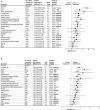Nonpharmacologic Interventions for Reducing Blood Pressure in Adults With Prehypertension to Established Hypertension
- PMID: 32975166
- PMCID: PMC7792371
- DOI: 10.1161/JAHA.120.016804
Nonpharmacologic Interventions for Reducing Blood Pressure in Adults With Prehypertension to Established Hypertension
Abstract
Background Nonpharmacologic interventions that modify lifestyle can lower blood pressure (BP) and have been assessed in numerous randomized controlled trials and pairwise meta-analyses. It is still unclear which intervention would be most efficacious. Methods and Results Bayesian network meta-analyses were performed to estimate the comparative effectiveness of different interventions for lowering BP. From 60 166 potentially relevant articles, 120 eligible articles (14 923 participants) with a median follow-up of 12 weeks, assessing 22 nonpharmacologic interventions, were included. According to the surface under the cumulative ranking probabilities and Grading of Recommendations Assessment, Development and Evaluation (GRADE) quality of evidence, for adults with prehypertension to established hypertension, high-quality evidence indicated that the Dietary Approach to Stop Hypertension (DASH) was superior to usual care and all other nonpharmacologic interventions in lowering systolic BP (weighted mean difference, 6.97 mm Hg; 95% credible interval, 4.50-9.47) and diastolic BP (weighted mean difference, 3.54 mm Hg; 95% credible interval, 1.80-5.28). Compared with usual care, moderate- to high-quality evidence indicated that aerobic exercise, isometric training, low-sodium and high-potassium salt, comprehensive lifestyle modification, breathing-control, and meditation could lower systolic BP and diastolic BP. For patients with hypertension, moderate- to high-quality evidence suggested that the interventions listed (except comprehensive lifestyle modification) were associated with greater systolic BP and diastolic BP reduction than usual care; salt restriction was also effective in lowering both systolic BP and diastolic BP. Among overweight and obese participants, low-calorie diet and low-calorie diet plus exercise could lower more BP than exercise. Conclusions DASH might be the most effective intervention in lowering BP for adults with prehypertension to established hypertension. Aerobic exercise, isometric training, low-sodium and high-potassium salt, comprehensive lifestyle modification, salt restriction, breathing-control, meditation and low-calorie diet also have obvious effects on BP reduction.
Keywords: hypertension; network meta‐analysis; nonpharmacologic interventions; randomized controlled trial; systematic review.
Conflict of interest statement
None.
Figures




Similar articles
-
Effects of comprehensive lifestyle modification on blood pressure control: main results of the PREMIER clinical trial.JAMA. 2003 Apr 23-30;289(16):2083-93. doi: 10.1001/jama.289.16.2083. JAMA. 2003. PMID: 12709466 Clinical Trial.
-
Determinants and consequences of adherence to the dietary approaches to stop hypertension diet in African-American and white adults with high blood pressure: results from the ENCORE trial.J Acad Nutr Diet. 2012 Nov;112(11):1763-73. doi: 10.1016/j.jand.2012.07.007. Epub 2012 Sep 19. J Acad Nutr Diet. 2012. PMID: 23000025 Free PMC article. Clinical Trial.
-
Is Concurrent Training Efficacious Antihypertensive Therapy? A Meta-analysis.Med Sci Sports Exerc. 2016 Dec;48(12):2398-2406. doi: 10.1249/MSS.0000000000001056. Med Sci Sports Exerc. 2016. PMID: 27471784
-
Dietary Approaches to Stop Hypertension (DASH) Diet and Blood Pressure Reduction in Adults with and without Hypertension: A Systematic Review and Meta-Analysis of Randomized Controlled Trials.Adv Nutr. 2020 Sep 1;11(5):1150-1160. doi: 10.1093/advances/nmaa041. Adv Nutr. 2020. PMID: 32330233 Free PMC article.
-
Overview of salt restriction in the Dietary Approaches to Stop Hypertension (DASH) and the Mediterranean diet for blood pressure reduction.Rev Cardiovasc Med. 2022 Jan 19;23(1):36. doi: 10.31083/j.rcm2301036. Rev Cardiovasc Med. 2022. PMID: 35092228 Review.
Cited by
-
Empowerment-based nutrition interventions on blood pressure: a randomized comparative effectiveness trial.Front Public Health. 2023 Nov 13;11:1277355. doi: 10.3389/fpubh.2023.1277355. eCollection 2023. Front Public Health. 2023. PMID: 38026295 Free PMC article. Clinical Trial.
-
Trends in cardiovascular risk factors and treatment goals in patients with diabetes in Singapore-analysis of the SingHealth Diabetes Registry.PLoS One. 2021 Nov 8;16(11):e0259157. doi: 10.1371/journal.pone.0259157. eCollection 2021. PLoS One. 2021. PMID: 34748574 Free PMC article.
-
An updated network meta-analysis of non-pharmacological interventions for primary hypertension in adults: insights from recent studies.Syst Rev. 2024 Dec 31;13(1):318. doi: 10.1186/s13643-024-02744-5. Syst Rev. 2024. PMID: 39736688 Free PMC article.
-
Safety, efficacy and delivery of isometric resistance training as an adjunct therapy for blood pressure control: a modified Delphi study.Hypertens Res. 2022 Mar;45(3):483-495. doi: 10.1038/s41440-021-00839-3. Epub 2022 Jan 12. Hypertens Res. 2022. PMID: 35017680 Free PMC article.
-
Promoting lifestyle change through text messages to patients with hypertension: A randomized controlled trial in Swedish primary care.Prev Med Rep. 2025 Feb 17;51:103009. doi: 10.1016/j.pmedr.2025.103009. eCollection 2025 Mar. Prev Med Rep. 2025. PMID: 40065756 Free PMC article.
References
-
- Lip GYH, Coca A, Kahan T, Boriani G, Manolis AS, Olsen MH, Oto A, Potpara TS, Steffel J, Marín F, et al. Hypertension and cardiac arrhythmias: executive summary of a consensus document from the European Heart Rhythm Association (EHRA) and ESC Council on Hypertension, endorsed by the Heart Rhythm Society (HRS), Asia‐Pacific Heart Rhythm Society (APHRS), and Sociedad Latinoamericana de Estimulación Cardíaca y Electrofisiología (SOLEACE). Eur Heart J Cardiovasc Pharmacother. 2017;235–250. - PubMed
-
- James PA, Oparil S, Carter BL, Cushman WC, Dennison‐Himmelfarb C, Handler J, Lackland DT, LeFevre ML, MacKenzie TD, Ogedegbe O, et al. 2014 evidence‐based guideline for the management of high blood pressure in adults: report from the panel members appointed to the Eighth Joint National Committee (JNC 8). JAMA. 2014;507–520. - PubMed
-
- Forouzanfar MH, Liu P, Roth GA, Ng M, Biryukov S, Marczak L, Alexander L, Estep K, Hassen Abate K, Akinyemiju TF, et al. Global burden of hypertension and systolic blood pressure of at least 110 to 115 mm Hg, 1990–2015. JAMA. 2017;165–182. - PubMed
-
- Vasan RS, Larson MG, Leip EP, Evans JC, O'Donnell CJ, Kannel WB, Levy D. Impact of high‐normal blood pressure on the risk of cardiovascular disease. N Engl J Med. 2001;1291–1297. - PubMed
Publication types
MeSH terms
LinkOut - more resources
Full Text Sources
Medical

